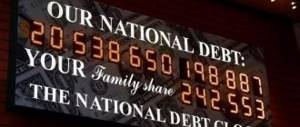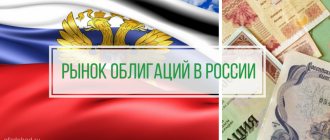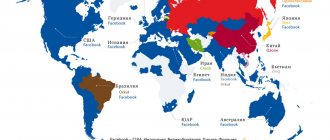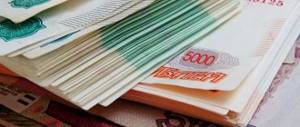External public debt of Russia
Editorial
Promdevelop editorial team
The law of the Russian Federation adopted in 1992 divided public debt into external and internal.
Russia's public debt for 2021 is divided into external and internal loans, respectively, with the currency of the obligations incurred. A loan in foreign currency refers to the external debt of the Russian Federation, and a loan in rubles refers to the internal debt. According to Article 6 of the Budget Code of the Russian Federation, the external debt of the state is the country’s obligation arising in foreign monetary units.
The state external debt of the Russian Federation includes the following obligations:
- Central Bank;
- federal authorities;
- federal subjects.
The Central Bank is the official source of information on the structure, history, current status and payment plan.
Lenders are usually:
- other states;
- private foundations;
- MFO.
Historical data
- In fact, the State Debt appeared in 1991 after the collapse of the Union of Secular Socialist Republics, when the Russian Federation, as a successor, took over all debt obligations.
- Due to the severe economic crisis in the 1990s after the collapse of the USSR, Russia practically did not repay its loans and took out new ones. The volume of external debt of the Russian Federation grew until 1998 and amounted to $188 billion. After the peak and end of the crisis in 1998 and overcoming the default, the size of official payments began to decline (see Is Russia at risk of default in 2021?).
- In the early 2000s. The Russian Federation began to strengthen its economic position thanks to rising oil prices.
- Already in the summer of 2006, as a result of lengthy negotiations, the Paris Club loan was prematurely repaid - $22.5 billion.
- By 2008, due to available foreign loans, the debt had risen again to 0.5 Tron. $.
- In 2013, loans from the USSR were repaid. A total of $3.65 billion was paid to the following countries: Montenegro, Czech Republic and Finland.
- The next maximum was reached in 2014 – more than $0.7 trillion. After which it began to decline quite quickly due to sanctions.
- At the end of 2014 - beginning of 2015. over $0.1 trillion were paid out in just a few months. Which ultimately led to a currency crisis and a depreciation of the ruble.
- In the summer of 2021, the Soviet Union's national debt in the amount of $125.2 million to Bosnia and Herzegovina was repaid.
Russian external debt chart
Forecast
Taking into account the forecast data, it is worth noting that in the next few years, internal debt will increase and external debt will gradually decrease. Another interesting point to note is that by last summer (2019), assets amounted to about 1.25% of the projected gross domestic product for the same period based on government estimates.
As of January 1, 2021, public debt with an expanded understanding exceeded public assets by 1.5% of GDP. Thus, Russia currently has no net debt. Thus, the Russian economy is one of the most interesting according to some analysts. Certain political conditions forced the government to increase reserves and control debt discipline rather strictly. True, due to such a tough approach, the situation related to the development of the economic situation in the country worsened.
According to analysts, today Russia can afford to increase its total debt by 50% without jeopardizing its financial stability. This is a pretty good reserve for accelerating the slow pace of economic growth.
Assessments of the state and dynamics of the external debt of the Russian Federation
Due to the introduction of sanctions imposed on the Russian Federation, the amount of debt in digital terms is decreasing, but in relative terms it is growing. Experts believe that this can be explained by a decrease in GDP, a fall in the ruble exchange rate and a reduction in energy exports due to a decrease in world prices for them.
Current sanctions against Russia in 2021: reasons, counter-sanctions, significance for the economy
According to experts, the growth dynamics of Russia's external debt is not critical in relation to the debt of some other world powers.
According to forecasts, Russia's external public debt for 2018-2019 will continue to grow. Despite the payments planned for this period.
Russia's GDP and external debt: According to relative indicators, public debt is approximately 5-10% of total GDP, this figure is lower only for 4 world powers.
Why is Russia paying off its debts so quickly?
In terms of the rate of reduction in external debt, Russia has taken first place among the countries of Europe, Africa and the Middle East. In a little more than 4 years, Russia managed to reduce its debt by 36%. In 2014, the debt was more than $700 billion, and in 2021 it is $467 billion. By comparison, it took Hungary 8 years to reduce its debt by 27%.
Russia has been actively reducing debt since 2014, but the latest stage of reduction has not only affected the financial sector. In the first half of 2021, injections into federal loan bonds (OFZ) increased. This was compensated by payments from government organizations that paid off obligations to other countries.
Russia was forced to take first place in debt repayment. This was mainly due to the closure of capital markets. Borrowing money is now either very expensive or completely impossible. On the one hand, the sharp reduction in Russia's external debt increases pressure on the Russian ruble, and on the other hand, the influence of external debt on the ruble as a whole is noticeably decreasing.
UBS forecasts that further debt reduction may cause capital flight from the private sector. And this, in turn, will negatively affect the exchange rate of the Russian ruble.
Structure of Russia's external debt for 2018
Russia's external debt in 2021 consists of the following categories:
- External public debt;
- Commitments to members of the Paris Club;
- Debt payments to creditors who are not members of the Paris Club;
- Obligations to former states of the Council for Mutual Economic Assistance;
- Commercial loans of the former Union of Soviet Socialist Republics;
- Obligations to financial international organizations;
- Repayment of Eurobond loans;
- Bonded loans;
- Payments under OVGVZ.
The structure of the external debt of the Soviet Union includes:
- Installment contracts;
- Medium-term or short-term loans on a commercial basis, which are evidenced by bills and drafts (securities);
- Bills and drafts with payments for bearers;
- Collection is a banking transaction involving the transfer of money to the recipient from the payer through the bank. A fee is charged for performing this operation;
- Irrevocable and revocable obligations, including bank letters of credit with installments;
- Other arrangements related to authorization by resolution of governing bodies.
Almost all of the debt consists of Eurobond loans. Securities are Eurobonds that are issued in monetary units that differ from the state currency.
US foreign debt - Why don't debts prevent the US economy from growing?
What is external debt and what does it include?
The economy of a family, an enterprise, a bank and a country is based on a budget. It makes it possible to plan expenses based on income. And if in the case of a family the plan is kept in the head, then for the country it is a document in the form of a Law.
The budget is replenished by:
- tax revenues;
- rents on natural resources, such as oil, gas, minerals;
- profits from the export of goods and services of state-owned enterprises;
- percent from the Government's purchase of securities of other countries, etc.
The expenditure part includes costs for medicine and education with science, defense, social security, infrastructure development and much, much more.
Almost always, state budget expenditures exceed revenues. There is a shortage of funds. If it is in the range from 0.1 to 3%, nothing terrible happens - due to the growth of internal inflation, the budget deficit is covered. It’s another matter when there is a large shortage of funds, for example, oil and gas prices have dropped sharply, but the military has to pay pensions, salaries for teachers and doctors.
Roads and hospitals also need to be built. In this case, the state resorts to a loan. Money can be borrowed within the country from the population, banks, and that part of the economic sector that produces goods and provides services (it is called the corporate sector). If the deficit cannot be repaid, they enter the international securities market, where they offer bonds at a certain interest rate. And the higher it is, the faster the package is sold out.
This is the classic model of government debt. But life is more varied. Therefore, external debt also contains other monetary obligations. Their complete list can be seen from the definition of external debt in economics textbooks.
External public debt is the financial obligations of the state to subjects of international law: countries, funds, banks, and the corporate sector. The debt includes: payment of interest on securities and foreign loans, repayment (redemption) of securities upon expiration and repayment of the loan, guarantees for loans issued by foreign banks to national corporations and companies, obligations to pay for imports.
From the above definition we can draw an important conclusion: there is no country in the world without external debt . Even China, with its powerful financial resources, has it - it is formed simply: the company bought the goods with deferred payment. Until the money goes to the seller, the state, represented by the buyer, has a debt.
Who does Russia owe? External debt by year
The Ministry of Finance reported that the external debt of the Russian Federation decreased after the borrowings of the Soviet Union were blocked. Currently there is only one debt to South Korea. According to the agreements, it must be repaid by 2025.
- The state external debt of the Russian Federation (including the obligations of the former USSR accepted by the Russian Federation) for 2019 is 53,954.6 million US dollars. .
- The state external debt of the Russian Federation (including the obligations of the former USSR accepted by the Russian Federation) as of January 1, 2021 is 54,848.3 million US dollars. See document from the Ministry of Finance.
- State external debt of Russia (including obligations of the former USSR accepted by the Russian Federation) 56,786.0 million US dollars as of January 1, 2021. See the Ministry of Finance report for 2021.
External debt of world powers, predicted by the IMF
To compare the external debt of the Russian Federation with the debts of other countries, it should be clarified that the economy of each country is unique, as is the accounting methodology. For example, Japan's debt in 2015 reached 250% of annual GDP, which means that all Japanese could work for 2.5 years only to fulfill external obligations. But at the same time, Japan is one of the main creditors of the United States.
And if all countries demanded the return of their receivables, it remains to be seen which state would be in the most critical situation. Therefore, when talking about the external debt of the state, they always link the value to the GDP indicator for clarity and comparability of indicators.
In addition to real data on the external debt of countries around the world, the IMF also compiles projected indicators, which are given as a percentage of the state’s annual GDP:
| A country | 2020 | 2021 | 2022 | 2023 |
| Australia | 38,74 | 36,12 | 34,18 | 32,24 |
| Belarus | 49,63 | 47,49 | 46,12 | 43,22 |
| Canada | 81,16 | 78,68 | 74,41 | 74,26 |
| China | 57,56 | 60,45 | 63,05 | 65,45 |
| EU | 76,76 | 74,63 | 72,41 | 70,16 |
| Russia | 19,95 | 20,01 | 20,14 | 20,35 |
| Ukraine | 71,68 | 66,92 | 63,05 | 59,37 |
| Great Britain | 85,18 | 84,52 | 83,62 | 82,51 |
| USA | 111,26 | 113,12 | 115,23 | 116,87 |
| Japan | 232,29 | 231,43 | 230,71 | 229,65 |
From the above forecast data compiled by the IMF, it is clear that Russia is in one of the most favorable positions compared to other countries in terms of external debt. The forecast was compiled and published back in 2021 for 185 countries, so current indicators may differ significantly from those predicted, but they are enough for clarity.
Russia's external debt in 2021
Russia has reduced its external debt . As stated by the Central Bank of Russia, the external debt of the Russian Federation, as of January 1, 2021, is $470.1 billion, which is $21.3 billion less than a year ago.
It is noted that a decrease in debt obligations to non-residents was recorded in all sectors of the economy. The most noticeable, as noted by representatives of the regulator, was the reduction in foreign debt of other sectors related to attracted loans.
Let us recall that in the period from February to March 2021, the Russian economy was simultaneously affected by the COVID-19 pandemic, which had a detrimental effect on the global economy as a whole, as well as the collapse in oil prices.
In this regard, the ruble has depreciated significantly against the dollar and euro. In order to support the economy and population, the Russian authorities have consistently introduced several packages of relevant measures.
Thus, the volume of anti-crisis support during the COVID-19 pandemic amounted to 4.5% of GDP, which made it possible to overcome a particularly difficult period without serious irreversible losses. According to data as of January 15, the decrease in the international reserves of the Russian Federation amounted to 1.2%, compared with the figures for January 8, fixing at around $590.4 billion.
Experts cite negative exchange rate revaluation and lower gold prices as the main reason for the reduction in reserves. Let us recall that international reserves, which are foreign assets characterized by high liquidity and available to the Government of the Russian Federation and the Bank of Russia, consist of special drawing rights, funds in foreign currency, monetary gold, as well as a reserve position in the IMF.
External debt of the Russian Federation in 2021
Since 2014, Russia's net debt has dropped to negative levels. Since the second half of 2021, the debt of the Russian Federation has been fully covered by the liquid assets of the extended government. This means that if the country were to immediately repay the entire amount of the debt, it would do so only through government deposits with the Central Bank and commercial organizations.
Between 2014 and 2021, Russia maintained strict macroeconomic discipline. But this approach also has a negative side - there is a lack of internal incentives to improve the economic condition of the country.
The list of financial assets exceeded the debt of the Russian Federation at the end of August 2021. According to RBC, the following indicators were observed:
- The amount of debt of the federal government, regions and municipalities as of August 1, 2019 amounted to 16.2 trillion rubles. RF.
- Liquid state assets, which include deposits of the Bank of Russia and other banks in national and foreign currencies, amounted to 17.6 trillion rubles as of 08/01/2019.
- The net debt of the general government is about 17 trillion rubles. In 2018, this figure decreased to 14.6% of GDP, and government assets increased to 13.4% of GDP.
- Government deposits amounting to 6.5 trillion rubles and the currency purchased by the Ministry of Finance in January-August according to the budget rule - 2.1 trillion rubles. This money has not yet been transferred to the National Welfare Fund.
- In the Pension Fund and on deposits in the Treasury and banks - 0.6 trillion rubles.
The increase in indicators was influenced by two circumstances. First, due to sanctions and the closure of foreign markets, the state had to accumulate money to cover its own expenses. The second circumstance is that the 1998 crisis forced Russia to pursue a policy when short-term loans turned out to be unavailable and it became difficult to service them.
Interesting facts about the external debt of the Russian Federation
On August 8, 2021, the Russian Federation fully paid off the debts of the USSR, paying over $125 million to Bosnia and Herzegovina.
Interesting: history of the US dollar
Over 10 years, Russia has forgiven $80,000,000,000 to debtor states. Among the countries whose debts were written off:
- Cuba – $31.7 billion,
- Iraq - 21.5,
- Mongolia – 11.1,
- Afghanistan – 11,
- DPRK – 10,
- Syria – 0.9,
- Vietnam – 9.4,
- African states, including: Angola, Nicaragua, Ethiopia, Libya, were forgiven payments in the amount of more than 0.02 trillion dollars.
The Russian Federation has a debt to only one power - South Korea in the amount of $594 million.
And the debt is growing
The volume of Russia's external public debt has broken the long-term target.
The dynamics of the debt burden and the cost of servicing it directly affect the stability of the macroeconomic parameters of the state. Assessments of the drivers of the Russian economy for 2021 can be found in our special material.
According to the Ministry of Finance, as of January 19, 2021, the volume of Russian public external debt by the beginning of the year amounted to $56.79 billion. The amount includes state guarantees of the Russian Federation (31% of the gross debt).
Let's see whether the scale of the threat from the growth of public debt is so great, let's analyze its structure and repayment schedule, and evaluate the relative indicators of Russia's debt burden relative to the size of the national economy compared to the largest countries in the world.
As of January 1, 2021, we see that the maximum amount of external borrowing over the past 10 years has been exceeded. Since 2011, the figure has increased by 42%. The previous peak occurred in 2014, when global geopolitical changes occurred.
Throughout 2014–2015 there was a massive outflow of capital from the country: foreign direct investment (FDI) collapsed by the beginning of 2016 by more than 10 times, from $69.2 billion at the end of 2013 to $6.8 billion at the end of 2015. And at the same time Russia has reduced its debt to creditors by 10%.
The rhythm of payments is shown on the graph. Payments over time of debt repayment are distributed unevenly.
The annual payment includes expenses on government securities in foreign currency, loans from foreign governments and international financial organizations. Almost $7 billion will be paid in the next 3 years.
The debt structure is presented in the diagram. The share of external bond loans accounts for 2/3 of Russia’s external government debt with a maturity date of up to 2047.
By economic standards, updating the long-term external government debt level is uncritical. The estimated volume of Russia's GDP for 2021 is 107.9 trillion rubles, or about $1.45 trillion. Thus, external federal borrowing amounts to less than 4% of GDP.
Regarding other major economies of the world that are members of the G20 group, according to Trading Economics estimates based on World Bank data, the picture for the Debt/GDP indicator is presented below. It should be clarified that the debt indicator here includes the amount of external and internal borrowing.
Russia ranks first in the world in terms of the minimum debt burden on the economy. Current World Bank data for 2021 does not take into account the failure of the coronavirus crisis, which caused a record drop in the GDP of national economies and a rapid increase in debt. But as relative values on a date, the rating is indicative.
According to operational data at the beginning of 2021, a similar coefficient for Russia is 17.6%. The rate of change in the indicator is high, primarily due to the increase in domestic debt: in 2021, borrowing within the country in national currency increased by 45.4%, to $198 billion. The indicator is also influenced by a significant change in the exchange rate, as well as the decline in GDP itself against the background of the crisis.
Against the background of restrictive measures due to the pandemic, not only Russia, but also most countries of the world are resorting to expanding the debt burden to finance the budget deficit and support infrastructure projects. A soft monetary rate with a falling cost of funding ensures the relative stability of macro indicators, and with it the long-term attractiveness of the country's financial assets.
As the acute phase of the crisis passes, tax sources of budget financing are replenished and the need for large-scale social support decreases, the rate of debt growth will naturally decrease. In the basic case, this factor can lead to a more confident strengthening of the national currency closer to the second half of 2021, and help the Russian stock market reduce the global discount to international risk capital markets.
BCS World of Investments
Current trend
Over the past 4 years, the size of public debt has gradually decreased. At first glance, this is a positive trend, which indicates the end of the crisis period and the adaptation of the Russian economy to current market realities. But in fact, this is not due to the fact that Russia refused to use creditors’ funds, began to repay external debts faster and completely cover the budget deficit with incoming revenues. In 2014, when, due to the situation in Ukraine, the Russian Federation was practically deprived of the opportunity to use borrowed resources, its public debt decreased sharply, as a result of which private business suffered colossal losses, which even resulted in bankruptcy for some market participants.
Despite the fact that in absolute terms the external public debt has indeed become smaller, if we analyze the relative indicators, it becomes obvious that the situation is only getting worse. As analysts at the Higher School of Economics explain, this is due to a decline in GDP, a significant drop in the value of the ruble, instability in commodity markets, a significant decrease in exports and a decrease in energy costs. Thus, if net external borrowing (less repayments) was 0.6% of GDP in 2021, it will rise to 1.1% of GDP in 2021. And by the end of the three-year budget cycle, the amount of debt will exceed 100% of state budget revenues, which is unacceptable from the point of view of the public finance management program.
During the first three months of 2021, Russia will have to pay about $15.269 billion. on external obligations, and if it fails to fulfill its obligations, this can lead to serious consequences.
External debt per capita
| Date of assessment | External debt per capita, $ |
| 2018 | 3540 |
| 2017 | 3527 |
| 2016 | 3486 |
| 2015 | 3539 |
| 2014 | 4100 |
| 2013 | 5072 |
| 2012 | 4440 |
| 2011 | 3767 |
| 2010 | 3420 |
| 2009 | 3262 |
| 2008 | 3381 |
| 2007 | 3270 |
| 2006 | 2202 |
But we are returning home. Here we are interested in Russia's upcoming payments on its external debt. Traditionally, the largest payments are recorded at the end of the year. See the external debt repayment schedule for principal and interest.
How is debt formed?
When the expenditure side of the budget exceeds the revenue side, the state can take advantage of the only option available to it and cover the deficit with borrowed funds. A similar practice is used by private financial institutions (primarily commercial banks), which use borrowed resources to cover debts or invest in new projects.
The total debt of the state and its individual subjects forms external public debt, but the Russian Federation also assumed obligations to repay Soviet loans that were received before the collapse of the USSR.
At the moment, Russia must fulfill its obligations:
- to countries that are not members of the Paris Club;
- before states that are former members of the Economic Cooperation Council;
- to multilateral lending partners;
- on bonds intended for obtaining an internal loan;
- on guarantees in foreign currency, etc.
Content
- Russian government debt is at a low level
- Consequences of the pandemic: Russian government debt has increased, but less than in other countries
- OFZ sales in February-March 2021 were offset by domestic demand
- The need for borrowing for the budget is low
- The risk of sanctions has already largely materialized
- Russian debt is stable
Anton Tabakh, Managing Director for Macroeconomic Analysis and Forecasting, Expert RA
Anton Prokudin, leading methodologist at Expert RA
Anastasia Podrugina, lecturer at the Faculty of World Economy and International Politics, National Research University Higher School of Economics
The introduction of the second package of sanctions from the Biden administration on April 15, 2021, on the one hand, brought to life one of the pessimistic scenarios for the Russian economy: the introduction of restrictions on Russian government debt. On the other hand, the restrictions turned out to be not the most stringent: the purchase of Russian government bonds on the primary market is prohibited, and the level of uncertainty and tension in the markets has significantly decreased. The markets reacted with stabilization - the slight decrease in the ruble on April 15 was very quickly compensated, and the OFZ market responded with growth.
The ban on US companies (not individuals and most likely not US hedge funds typically domiciled outside the US) does not apply to the secondary market where these transactions primarily took place. There were practically no American banks on the primary market for Russian debt even before the mass departure of non-residents. A similar ban - even broader due to restrictions on settlements in dollars for issues - has been in effect for Russian Eurobonds since 2021. The result is that new loans are issued in euros or other currencies. The resources of the Bank of Russia make it possible to maintain liquidity, and the weak ruble, combined with comfortable prices for export goods, has filled the Russian treasury so much that borrowing can be stopped for some time or managed by domestic and foreign investors who are not afraid of sanctions.
At the same time, the inclusion of the primary OFZ market in the sanctions list increases the overall toxicity of Russian assets, and particularly alarming compliance managers will try to avoid them - no matter what happens. Therefore, the return of non-residents after the market situation has stabilized will be slower and sadder than, for example, in 2018.
The second dangerous point is the phrase from the sanctions decree granting the “government,” that is, the Ministry of Finance and the State Department, the authority to impose new restrictions on Russian sovereign debt by orders of a lower level than the presidential decree. This creates a constant threat of “sneaky” sanctions, although further escalation is still unlikely for the Russian debt market. For example, the ban on holding OFZs is generally hampered by lobbying from the American financial sector.
Overall, the new round of sanctions does not pose immediate risks, but in the long term they act as a shackle on the Russian economy and financial sector. The expansion of sanctions requires new efforts to adjust to them, the toxicity or implied toxicity of Russian assets increases the cost of borrowing or interferes with transactions - thereby reducing the opportunities for attracting investment and economic growth to the private sector.
Could future sanctions cause pain to the state and the market if the budget is well filled? “Is there life” during and after a pandemic? Will the imbalance caused by the outflow of foreign investors be balanced by domestic demand, as well as the reserve capacity of the Central Bank?
- In 2021, high domestic demand for OFZs, combined with low rates and the need for borrowing to finance coronavirus expenses, significantly expanded the market. Despite this, the ratio of Russian government debt to GDP remains at low levels.
- At the beginning of 2021, the OFZ market experienced a period of significant volatility associated with both increased inflation expectations in the United States and the increased likelihood of new sanctions being introduced; yields on Russian securities increased.
- The revenue side of the federal budget began to recover in March 2021 (probably largely due to pent-up demand), and therefore the Ministry of Finance announced a revision of the borrowing plan. Taking into account comfortable oil prices, all other things being equal, the Russian budget will not require significant borrowing in 2021.
- The outflow of foreign capital from OFZs has already occurred to a large extent, the share of non-residents in OFZs is at an extremely low level - in the first half of 2021, the outflow of foreigners was caused by the withdrawal of capital from emerging markets, at the end of 2021 - beginning of 2021 - by sanctions fears.
- Foreign capital in Eurobonds declined rapidly in 2014-2016 in response to the annexation of Crimea, while the subsequent announcements of sanctions had little effect on the share of non-residents: non-residents laid down the possibility of imposing sanctions from the very beginning. The return of foreign capital into Eurobonds in 2021 has slowed down, primarily due to the pandemic.
- Further outflow of foreign capital - even if more serious sanctions are introduced - can largely be compensated by domestic demand, including through the use of Central Bank mechanisms. Through long repo, the Bank of Russia lends to commercial banks, which in turn use these funds to purchase government securities.
- Today we do not observe signs of destabilization of Russian government debt, although it is highly likely that we will observe a further small outflow of foreign capital and a slight increase in yields.











